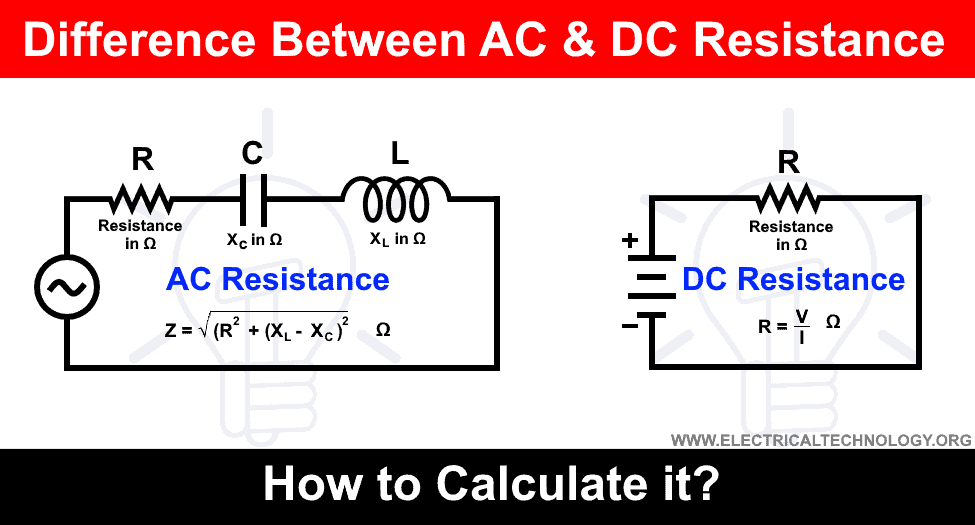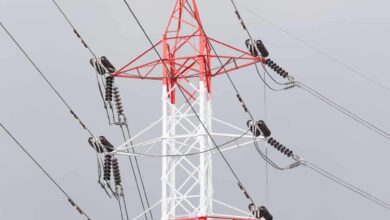Difference Between AC and DC Resistance – Which One is More?
Difference Between AC & DC Resistances & How to Calculate it?
Resistance
The property of a substance or material which oppose the flow of electricity through it is called resistance OR,
Resistance is the ability of a circuit or element (which is called resistor) to oppose the flow of current through it.
Examples of Resistors with the ability of high resistance are Wood, Air, Mica, Glass, Rubber, Tungsten etc.
Unit of Resistance is “Ohm” and it is denoted by Ω and it is represented by “R”.
- Related Post: AC or DC – Which One is More Dangerous And Why ?
AC Resistance
In Simple words, Resistance in AC circuits is called Impedance. Or
The Overall resistance (Resistance, Inductive reactance and Capacitive reactance) in AC circuits is called Impedance (Z).
Explanation:
When AC Current pass through a wire (resistor, inductor, capacitor), then current produces a magnetic field across that wire which opposes the flow of AC Current in it along with the resistance of that wire. This oppose cause is called Inductance or Inductance is the property of Coil (or wire) due to which opposes any increase or decrease of current or flux through it. Also, we know that inductance is only exist in AC because the magnitude of current continuously changing
Inductive Reactance XL, is the property of coil or wire in an AC circuit which opposes the change in the current. The unit of Inductive reactance is same as Resistance, capacitive reactance i.e. Ohm (Ω) but the representative symbol of capacitive reactance is XL.
Likewise,
Capacitive Reactance in a capacitive circuit is the opposition to current flow in AC circuits only. The unit of capacitive reactance is same as Resistance, Inductive reactance i.e. Ohm (Ω) but the representative symbol of capacitive reactance is XC.
- Related Post: What Happens When an AC Line Touches a DC Line?
Measuring AC Resistance
Electrical Resistance & Impedance Formulas in AC Circuits
In AC Circuits (Capacitive or inductive Load), Resistance = Impedance i.e., R = Z
Z = √ (R2 + XL2)… In case of Inductive Load
Z = √ (R2 + XC2)…In case of Capacitive Load
Z = √ (R2 + (XL– XC)2…In case of both inductive and capacitive Loads.
Good to know:
Where;
XL = Inductive reactance
XL = 2πfL…Where L = Inductance in Henry
And;
XC = Capacitive reactance
XC = 1/2πfC… Where C = Capacitance in Farads.
- Related Post: What is the Role of Capacitor in AC and DC Circuit?
DC Resistance
We know that there is no concept of Inductive and capactive reactances in DC Circuits. i.e. capacitive and inductive reactances in DC circuits zero because there is no frequency in DC circuits, i.e. magnitude of DC current is constant. Therefore, only the original resistance of wire comes into play.
Good to know:
That’s why the resistance offered by a wire is lower for DC than AC as will as AC lines need more insulation than DC.
Measuring DC Resistance
Electrical Resistance Formulas
In DC Circuits, we calculate the resistance by Ohm’s Law.
R = V/I.
Good to know:
When solving electric circuits for finding resistance and you are not sure which one should you take into account whether AC or DC resistances, then, if the current passed is AC, then take AC resistance else if the current passed is DC, take DC resistance.
- Related Post: Why Do Electronic Circuits Use DC Current instead of AC?
Which One is More – AC or DC Resistance ?
As we know that frequency in DC supply is zero, so there is no skin effect (a behavior of alternating current to flow through the surface i.e. outer layer of a conductor instead of the core of the wire). in DC circuits. Due to the skin effect, AC resistance are more in AC circuits than DC supply in DC circuits.
Skin Effect Formula
δ = √(2ρ/ωµ)
Where;
- δ = Skin effect depth
- ρ = Specific resistance
- ω = 2πf = Angular frequency
- µ = Permeability of the conductor
In short, frequency is directly proportional to the skin effect i.e. if frequency increase, skin effect also increase where, there is no frequency and skin effect in DC.
As a rule of thumb;
AC Resistance = 1.6 x DC Resistance
Related Posts:
- Difference Between a Battery and a Capacitor
- Difference Between Current and Voltage
- Why AC Needs More Insulation Than DC at Same Voltage Level?
- Why Can’t We Store AC in Batteries instead of DC?
- Why is Zero Ohm Resistor Used? 0-Ω Resistor Applications
- Resistor Color Code Calculator – 3, 4, 5 & 6 Band Resistors Calculation








Excellent <br />
well explanation. these r very useful 4 our studies
this is our basic
goooooooog
thank u bro for sending good concepts. its very useful for me to update my knoledge
brother can u explain what is the concept for estimate wire mm2 to current capacity?
It is really helpful not only to the students but also for all teaching community.
nice one
I would like to defer your definition of AC resistance. AC resistance is the resistance of the conductor, taking into effect the Skin and proximity effect. The one defined here is called inductive or capacitive reactance or impedance.
explanation of answer is as simple words that can easily understand evey one and good .
Excellet Explanation
Very naive and with errors: both kind of currents ac and dc running thru material, even insulation, create magnetic field proportionally to current; whatever natures of these magnetic fields are different. Please note: even air movement after nuclear explosion generates huge magnetic field which caused many scientific apparatuses damage in beginning of nuclear experiments. What kind is the current: DC or AC? Air with electrons is moving in one direction only (out of center of explosion), but high voltage is generated even is straight wire!
Very good information, thank you!
In dc, frequency is Zero so capacitive reactance and inductive reactance are infinity and zero. Then how capacitor and inductor used in DC system(choppers). How it work on DC .
thanks that wen page is help me to clear my concepts thanks again
I APPRECIATE YOUR POSTING.
I NEED A HAND BOOK ON ELECTRICAL TECHNOLOGY.
THANKS.
very importent basic electrical information
very useful article for techo-crafts
Supebbb explanation easily Know that the difference between an and DC currents thanks for the information
Thanks for the information